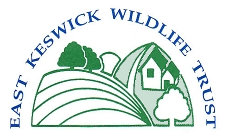Frank Shires Quarry and Meadow
This small nature reserve, open to the public, is owned by the Parish Council and managed on its behalf by the East Keswick Wildlife Trust. The footpath is permissive and not a right of way.
History
The quarry, south of the meadow, was excavated for the extraction of Magnesian Limestone at the time of the East Keswick Parliamentary Enclosure at the beginning of the 19th century, and designated as a public quarry. The stone from this quarry was crushed and burnt in nearby kilns to obtain lime, used for building purposes and as a fertiliser. After the quarry was abandoned, it reverted to woodland and now provides a variety of habitats, from sunny, war and sheltered to shaded, cool and damp.
Geology
The rock underlying the meadow and quarry is Magnesian Limestone, a rock rare in the British Isles. It was formed in the Permian period, some 250 million years ago, at the edge of a large inland sea, referred to as the Zechstein by geologists. It is part of an outcrop running in a narrow band from Nottingham in the south to South Shields in the north. Magnesian Limestone has been extensively quarried for its relatively hard stone and used for many domestic and public buildings in Wetherby, Boston Spa and also York Minster. However, it was never used as a building stone in East Keswick.
Flora and Fauna
Some of the flowering plants that can be found on the Magnesian Limestone grassland are Cowslip, Meadow Crane’s-bill, Field Scabious, Yellow-Rattle, Marjoram, Common Spotted and Bee Orchids. The rare Thistle Broomrape, found only on a few sites in Yorkshire and nowhere else in the UK, has been recorded flowering here over several years.
Plants that can be found in the quarry are; Wood Anemone, Twayblade, Sanicle, Sweet Violet, Dog’s Mercury, Three-Nerved Sandwort and the Hart’s tongue fern. Mosses and ferns with many varieties of fungi flourish in the damp shade. Ivy clothes many of the trees to give a rich habitat and shelter for numerous insects. The nectar produced by the Ivy flowers, in late autumn, is a valuable food source for insects.
Butterflies: Due to the varied habitats, many of the butterflies found in the parish breed here: In spring and early summer (April–June) Speckled Wood, Orange-tip, Holly Blue and Comma can be seen. Later in the year (July-September) Meadow Brown, Ringlet, Gatekeeper, Small and Large Skipper, Small, Large and Green-veined White, Peacock and Small Tortoishell can be found.
Management
This meadow is one of the few remaining unimproved pastures in the parish. Magnesian Limestone grassland is very restricted in the British Isles. Indeed, Britain has lost a staggering 98% of its meadow grassland since 1930. The meadow is not subject to intensive modern agricultural practices that, whilst maximising grass or crop yields, result in the loss of native wild flowers and grasses: food sources that insects, butterflies, bees, moths and their predators; birds and bats depend on. As such it is a valuable refuge in the parish for local wildlife.
At appropriate times of the year, the meadow is lightly grazed by the Trust’s flock of Hebridean and Soay sheep to maintain the flora of the Magnesian Limestone grassland and to prevent reversion to woodland. Some patches of bramble and scrub are left to provide safe nesting and shelter sites for summer migrant Warblers, Long-tailed Tits and other resident species. Managing the reserve in this way results in a balance between scrub, woodland and limestone pasture.
Look after our local nature reserves, more details of events and membership can be found within this website.
You are reminded that you take responsibility for your own safety whilst on this Reserve. Be aware that this site contains rock faces with vertical drops and some steep slopes. Paths and styles may be slippery and affected by debris.
The reserve is fragile, please take care of it
- Keep to the paths
- Dogs must be kept on a lead at all times.
- Cycling is prohibited
- No unauthorised camping or fires
- Please take your litter home
- Please do not remove any flora and fauna without permission.
- We hope you enjoy your visit.

